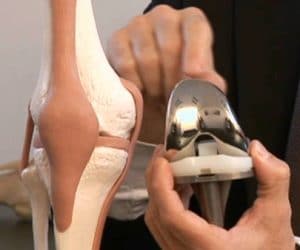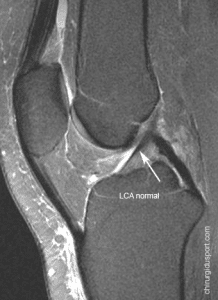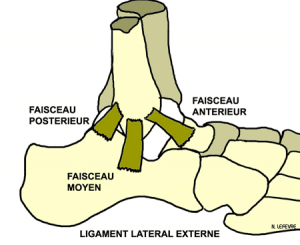Introduction
In 2007, the average age and life expectancy of the French population increase but also the prevalence of hip and knee osteoarthritis.
Approximately 100,000 total hip prostheses and 50,000 total knee arthroplasty
are laid each year.
Although the average age of the French population supporting a total hip replacement is 65, more and more young and active patients are candidates for replacement.
These patients are demanding on the functional performance of their prosthesis as often active and sports.
Currently, the life expectancy of a total hip replacement is more than 20 years (in 90% of cases) and more than 15 years for a total knee replacement, but can we make a life with prosthetics also long a patient who claims to have intense physical activity and without limitation.
To date, no French studies have been published on this subject, so we were forced to review the international literature; which is primarily interested in the total hip and total knee replacement.
SPORT AND PROSTHESIS:
In 1960, the first total hip prostheses implanted in patients CHARNLEY had as main objective to treat pain.
Today, this intervention aims, improve joint function by the treatment of pain, stiffness, instability, lameness, to resume normal daily activity and also an activity physical and sports.
According to the recommendations of the “American Association of Sports Medicine” (7,11,12) sport and physical activity is desirable and beneficial for the cardiovascular system and for musculoskeletal patients. Per week, should be performed at least 3 times 20 minutes of physical activity. This leads to an improvement in the general welfare also with a proven physiological benefits on diabetes, hypertension, obesity, coronary heart disease, osteoporosis, and also psychological benefits on anxiety or depression.
We must therefore encourage the sport of a patient with a prosthesis, but can we allow all sports?
Most articles in the literature usually recommend “the high level of impact sports and sports competitions” to avoid increased stress peaks and prosthetic loosening risk. However, there is no scientific study that confirms the reservation, and usually the authorization to practice a sport often based on knowledge and personal experience of the practitioner (surgeons, rheumatologists, sports medicine …. ).
After placement of a prosthesis, mastering sporting gesture and good practice previously practiced sport must allow recovery without limitation few months after surgery.
However it is not recommended to start and discover a sport; it should be considered dangerous and should be banned to the patient.
Some sports are in any case prohibited or strongly discouraged for patients carrying a prosthesis; as the pivot-contact sports, team sports (football, handball), pulse sports (volleyball, sports acrobatics).
However the recommended sports are primarily those where physical activity is not binding on the lower limb joints such as swimming, walking, hiking, cycling, sailing, golf, etc ….
Some sports such as tennis, skiing and golf have been studied in more detail in the international literature.
SPORTS AND TOTAL HIP PROSTHESIS
In 1999, MONT (10) published in “Sports Medicine,” a study of patients in practicing tennis club and holders of a total hip replacement. He interviewed 58 patients aged tennis players averaged 70 years (range 47-89 years). Seventeen patients had bilateral total hip arthroplasty 75 operated hips. This article is very interesting because in this population, 14 patients were operated on in order to continue to play tennis. The resumption of their sport was actually about 7 months after surgery, regularly three times a week, and the same level of tennis. The survival rate of the prosthesis was 96% at 8 years back, while in the general population survival to 10 years varies between 95 and 98% survival. SEYLER (13) arrived at the same conclusions in 2006. He did not show a higher rate of failure or takeover among tennis players compared to the general population.
In 2000, GSCHWEND (5), in a prospective study of 10 years, compared 50 patients practicing track skiing and 50 sedentary patients all holders of a total hip replacement at 5 and 10 years of decline. At last follow, he showed more wear among skiers, 2.1 mm wear compared to 1.5 mm wear but without surgical recovery.
A working DUBS (4) in 1985, showed that in a sedentary patient, polyethylene wear of a hip prosthesis is 0.10 mm / year and while it is 0.39mm / year in active patients , the decline in 7 years. Podometric a study showed that polyethylene wear is correlated to the number of daily and 30 polyethylene mm3 are worn per million of cycles not walk, for about 70kg.
So it seems that intense physical activity increases polyethylene wear, and thereby reduces the life of the prosthesis. Nevertheless, the relationship between prosthesis revision rate, age and physical activity level gives, depending on the work, discordant results. Beyond 10 years, the risk of prosthetic recovery seem more often linked to osteolysis phenomena periarticular, independent of mechanical stresses.
For information, the average lifespan of a total hip replacement in the general population is about 94% survival at 15 years and 77% survival at 25 years, while in the population of patients under 50 years so active, survival is 88% at 15 years and 69% at 25 years.
The recommendations made by the members of the “HIP Society” in 1999 (14) are summarized in Table 1. The results of the survey of 54 senior surgeons now possible to help us in the direction of the sport of our patients.
The findings of this study show that licensed sports in patients with a total hip replacement are the low-stress sports, without pivot touch. Must be avoided learning a new sport but can tolerate some sports if the technique is previously known and controlled. Finally, we must warn the patient of the risks of excessive wear in intense sports activity.
SPORTS AND TOTAL KNEE PROSTHESIS
This is a patient population most often 65 to 85, more common in women. In younger and active patients, there are conservative surgical treatments such as tibial valgus osteotomy gives good results. The average age of these patients was 52 years. It is therefore not in the same population.
In 2002, MONT (10) studied 33 older tennis players averaged 64 years, carrying a total knee replacement (46 knees). Their surgeons had authorized a resumption of doubles tennis in 45% and single in 21% of cases. The resumption of tennis had been possible approximately 1 year after the intervention, at a frequency of 3 times a week and at the same level. At 7 years of decline, there has been no revision surgery.
Golf was also studied in 1996 by Mallon (8.9). It conducted a survey among 83 golfers holders of a total knee replacement, 92% of these patients returned to golf without limitation. The resumption of golf was possible five months after surgery at a frequency of 3.7 times per week. In 84% of cases, patients showed no discomfort in their sport.
Two more recent studies BOCK (1), and CHAT (2), over 150 patients have shown a gradual evolution of sports activity patients to less stress at sports such as walking, swimming or cycling .
Unlike the hip it appears that the compressive stresses are greatest on the knee prosthesis The biomechanical study KUSTER (6) shown. It evaluated the strengths and constraint surfaces of a total knee prosthesis for 4 sports: cycling, walking, mountain hiking and jogging. He compared three types of total knee prostheses: standard bearing prosthesis, ultra-congruent plate and movable plate. The results are summarized in Table 2 and 3 .They show that the peak stress varies depending on the sport but also the knee flexion angle. Indeed 50 ° of flexion of the knee, this strength in the jogging is 9 times the body weight on the tibiofemoral compartment. It appears therefore the need to promote activities such as cycling and walking and jogging contraindicate see mountain hiking.
CONCLUSION:
The recovery in sport and physical activity after joint replacement is a question often asked by the patient to the surgeon but also the sports doctor and the attending physician.
This literature review should help to assist the practitioner to advise his patient.
The practice of physical activity is desirable for the cardiovascular system and the musculoskeletal system, we must encourage the resumption of a sport but also know the risks. We must focus on endurance activities, recreation, low
stress: walking, swimming, cycling, golf, etc …
Some sports most at risk may be authorized through a mastery of technical movement and after informing the patient of the risks of wear.
References:
1. Bock P et al, Physical activity after-total knee replacement (Orthop 2003)
2. Chatterji U. et al, Effect of total hip arthroplasty is recreational and sporting activity (AnzJ
Surg 2004)
3. Diduch DR et al. Total knee replacement in young, active patients.Long term follow-up and functional outcome.J Bone Joint Surg Am 1997; 79 (4): 575-82
4. The Dubs and after-al.Sports total hip arthroplasty.Arch Orthop Trauma Surg 1983; 101 (3): 161-9
5. N. Gschwend et al: Alpine and cross-country skiing after-total hip replacement: 2 Cohorts of 50 patients each, one active, inactive in l’autre skiing, Followed for 5-10 years. Acta Orthop Scand. 2000
6. Kuster MS et al. Endurance after-total knee replacement sports: a biomechanical investigation Med.Sci.Sports Exerc. 2000; 32 (4): 721-4
7. Macnicol MF Exercise testing before and after-hip arthroplasty JBJS 1980
8. Mallon WJ et al. Total hip arthroplasty in active golfers.J Arthroplasty 1992; 75 (Suppl): 339-46
9. Mallon WJ et al. Total knee arthroplasty in active golfers.Clin Sports Med 1996; 15 (1): 179-90
10. Mont MA et al. Tennis total knee arthroplasty after-. Am J Sports Med 2002; 30 (2): 163-6
11. Ries MD et al. Improvement in cardiovascular fitness total knee after-arthroplasty.1996 J Bone Joint Surg; 78A: 1696-701
12. Ries MD et al. Effect of total hip arthroplasty is cardiovascular fitness.J Arthroplasty 1997; 12: 84-90
13. Seyler TM. Sports activity total knee arthroplasty and hip after-: CIFIC recommendations concernant tennis Sport Med 2006
14. William L. et al, Athletic activity after-seal replacement Am J Sports Med 2001
Doctor Nicolas LEFEVRE, Doctor Serge HERMAN, Doctor Yoann BOHU. – 2 mars 2011.



